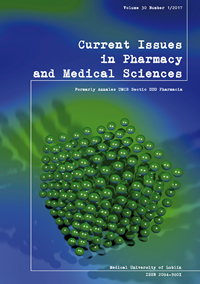Assessment of MT-279 compound effect on physical endurance of rats under conditions of chronic hypokinesia
DOI:
https://doi.org/10.1515/cipms-2017-0024Keywords:
chronic hypokinesia, physical endurance, actoprotectors, quinazoline derivatives, 2-ethylthiobenzimidazole hydrobromideAbstract
The objective of the study was to assess the effect of a sodium salt 3-(2-oxo-3-phenyl- 2H-[1,2,4]triazine[2,3-c]quinazolin-6-yl) of propanoic acid (MT-279 compound) on physical endurance of rats under conditions of chronic hypokinesia (15 days) in comparison with 2-ethylthiobenzimidazole hydrobromide (2-ETBI). The results of the conducted experiment showed that chronic hypokinesia (15 days) caused a progressive decrease in the physical endurance of animals. The signs of this phenomenon occurred already on the Day 7 of the experiment. It manifested by a significant decrease in the duration of rats swimming, treadmill runtime and holding on rotating rods (rotarod test). The course of MT-279 compound (2.5 mg/kg, ip) administered to animals in the specified experimental conditions contributed to restoration of physical performance of the study subjects. Upon introduction of the compound, the duration of rats` swimming on Day 7 of the experiment increased by 108.2%, and on Day 15 - by 64.2%. Administration of 2-ETBI caused the growth of this indicator by 70.5% and 24.2%, respectively. Along with this, we revealed an increase of rats` treadmill running time. On Day 7 and Day 15 of the experiment, we recorded 55.2% and 68.4% growth of the indicator, respectively. Daily administration of 2-ETBI contributed to 41.7% and 59.7% increase of running time, respectively. On Day 7 of MT-279 compound administration under the conditions of chronic hypokinesia, the duration of rats` rod retention time increased by 58.7% compared to 6.2% for 2-ETBI. On Day 15 of the experiment, the physical endurance of animals assessed under this test compared to the control group was 89.0% and 72.3%, respectively. On Day 7, MT-279 compound was significantly superior to the comparator drug in all tests performed for assessment of the ability to improve physical endurance under conditions of chronic hypokinesia. On Day 15 of study, the statistically significant superiority of MT-279 compound over 2-ETBI was identified in all forced swimming and rotarod tests.
References
1. Amtage F. et al. Hypokinesia upon pallidal deep brain stimulation of dystonia: support of a GABAergic mechanism. Front. Neurol., 1-6, 4, 2013. DOI: 10.3389/fneur.2013.00198
2. Contarteze R.V. et al. Stress biomarkers in rats submitted to swimming and treadmill running exercises. Comp. Biochem. Physiol. Part A: Mol. Integr. Physiol., 415-22, 151, 2008. DOI: dx.doi. org/10.1016/j.cbpa.2007.03.005
3. Kim H. G. et al. Effects of treadmillexercise on hypoactivity of the hypothalamo-pituitary-adrenal axis induced bychronic administration of corticosterone in rats. Neurosci. Lett., 46-49, 434, 2008. DOI: doi.org/10.1016/j.neulet.2008.01.025
4. Lucak I. V. et al. Stress-protective properties of the extract of the aspen cortex and its influence on the adrenocortical histology on the model of immobilization stress. Vrach-aspirant, 290-297, 3.2, 2013. Retrieved from: http://vrach-aspirant.ru/articles/pharmacology/13173/
5. Mak M. K. Y. Reduced step length, not step length variability is central to gait hypokinesia in people with Parkinson's disease. Clin. Neurol. Neurosurg., 587-590, 5, 2013. DOI: 10.1016/j. clineuro.2012.07.014.
6. Margolis L. M., Rivas D. A. Implications of Exercise Training and Distribution of Protein Intake on Molecular Processes Regulating Skeletal Muscle Plasticity. Calcif. Tissue Int., 211-221, 3, 2015.
7. Oliynyk S., Oh S. The Pharmacology of Actoprotectors: Practical Application for Improvement of Mental and Physical Performance. Biomol. Ther., 446-56, 20(5), 2012. DOI: 10.4062/ biomolther.2012.20.5.444
8. Pierre N. et al. Derbre. From physical inactivity to immobilization: dissecting the role of oxidative stress in skeletal muscle insulin resistance and atrophy. Free Radic. Biol. Med., 197-207, 98, 2016. DOI: https://doi.org/10.1016/j.freeradbiomed.2015.12.028
9. Saenko A. V., Zaichko N. V., Stepanyuk G. I. Effect of sodium salt of 3-(2-oxo-3-phenyl-2H-[1,2,4]triazine[2,3-c]quinazolin- 6-yl) propanoic acid and bemityl on biochemical processes in rats organism in the conditions of the daily training with running in treadmill. Curierul Med., 31-36, 57(6), 2014.
10. Selye H. (1974). Stress without Distress. Philadelphia: Lippincott.
11. Shabanov P. D. Neuroprotector Metaprot: mechanism of action and new clinical directions of use. Consilium Med., 2010; 12(2): 140-144.
12. Shiotsuki H. et al. A rotarod test for evaluation of motor skill. J. Neurosci. Methods, 180-85, 189(2), 2010. DOI: 10.1016/j. jneumeth.2010.03.026
13. Stepanyuk G. I. et al. Screening of actoprotective activity among derivatives of quinazoline and its condensed analogues. Pharmacol. Drug. Toxicol., 60-63, 4(17), 2010.
14. Toziuk O. Yu. Actoprotective action of sodium 2-(tetrazol[1,5-c] quinazolin-5-ylthio)acetate in acute hemic hypoxia. Zaporozhye Med. J., 12-14, 1(100), 2017. DOI:10.14739/2310-1210.2017.1.91722
Downloads
Published
Issue
Section
License
Copyright (c) 2017 Authors

This work is licensed under a Creative Commons Attribution-NonCommercial-NoDerivatives 3.0 Unported License.


